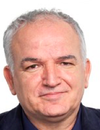Co-Located Conference AgendasLab-on-a-Chip & Microfluidics Europe 2019 | Organ-on-a-Chip & Tissue-on-a-Chip Europe 2019 | Point-of-Care, Biosensors & Mobile Diagnostics Europe 2019 | 

Tuesday, 18 June 201907:45 | Conference Registration, Materials Pick-Up, Morning Coffee and Tea in the Exhibit Hall | 08:45 |  | Conference Chair Chairperson's Welcome and Introduction to the Conference
Nancy Allbritton, Kenan Professor of Chemistry and Biomedical Engineering and Chair of the Joint Department of Biomedical Engineering, University of North Carolina and North Carolina State University, United States of America
|
| |
Session Title: Opening Plenary Session |
| | 09:00 |  | Keynote Presentation Optofluidic Labs-on-Chip For Single Molecule Analysis
Holger Schmidt, Narinder Kapany Professor of Electrical Engineering, University of California-Santa Cruz, United States of America
Lab-on-chip devices have long held the promise of providing a convenient
and rapid way to analyze small amounts of biological samples. However,
when pushed to the ultimate limit of single molecule sensitivity, the
detection mechanism is often based on off-chip elements. I will discuss a
chip-scale platform that offers both integrated optical and electrical
single molecule analysis. Optical integration is achieved by using
liquid-core waveguides interfaced with traditional photonic elements to
implement advanced functionalities. Examples include multiplex detection
of single viruses, simultaneous detection of proteins and nucleic acid
biomarkers, and front-to-back sample handling and single DNA detection
on a single chip. Electrical single molecule analysis is achieved by
integration of solid-state nanopores. Novel nanopore detection
capabilities such as feedback-controlled delivery of single molecules to
a fluidic channel are demonstrated. The combination of both optical and
electrical detection modalities results in a novel, high throughput
platform for single molecule analysis. |
| 09:30 |  | Keynote Presentation Organs-on-Chips: Analytical Tools and Objects for Analysis
Elisabeth Verpoorte, Chair of Analytical Chemistry and Pharmaceutical Analysis, University of Groningen, Netherlands
Organs-on-chips (OoC) can be viewed as biological processing units, meant to replicate on a smaller scale the cell architecture and functioning of the organs they represent. OoC may be used to probe and thus better understand the mechanisms by which organs function. Mostly, though, they will be used as in vitro processing tools, to yield insight as to the fate of compounds like drugs or foodstuffs in vivo. Either way, merging analytical detection technologies with microfluidics and cell culture is key to the development of these systems for advanced in vitro analysis. Several examples of analytical approaches for monitoring liver slice behavior stemming from our labs will be presented in this presentation. |
| 10:00 |  | Keynote Presentation New Opportunities in Acoustofluidic Processing of Liquid Biopsies
Thomas Laurell, Professor, Lund University, Sweden
Blood sampling and molecular analysis of plasma is the most common clinical diagnostic modality in modern health care. With more advanced means to downstream processing, sub components of blood can be isolated, improving the diagnostic outcome. Detection and analysis of rare events is specifically an area where high performance isolation of sub components of blood is critical and where lab-on-a-chip technology has paved the way for several new approaches. Acoustic forces in combination with microfluidics has open new avenues for high performance blood cell separation, enabling isolation of cancer cells from blood, leukocyte sub populations and more recently also enrichment and purification of extracellular vesicles. Our initial efforts in isolating circulating tumor cells using acoustophoresis in clinical scale prostate cancer patients samples will be reported.
Although conventional acoustophoresis is limited in is ability to manipulate particles smaller than 1 um secondary acoustic effects can alleviate this short coming. Scattered ultrasound between larger particles, that can be retained in a local acoustic field in a microchannel, can be utilized to enrich submicron vesicles on the larger “trapping particles”. Based on this we have developed a microfluidic platform that enables isolation of extra cellular vesicles (EVs) from biofluids such a urine, blood plasma and cell culture medium without the need for ultracentrifugation. Further, benefits of isolating EVs by means of acoustic trapping is rapid processing that provides relatively high recoveries (up to 60-80%), yet handling small sample volumes (20-50 uL blood plasma), giving access to molecular profiling of extra cellular vesicles in biobanks. Our studies have demonstrated protein and miRNA profiling of blood plasma EVs from myocardial infarction patients as well as in urine samples from healthy donors. More recently we have been able to detect EV protein biomarker profiles in heart transplant patients with acute rejection which could not be detected in blood plasma. |
| 10:30 | Morning Coffee, Tea and Networking in the Exhibit Hall | 11:15 |  | Keynote Presentation Nanosensor Chips for the Single-Molecule Sequencing of DNA and RNA
Steve Soper, Foundation Distinguished Professor, Director, Center of BioModular Multi-Scale System for Precision Medicine, The University of Kansas, United States of America
We are generating a single-molecule DNA/RNA sequencing platform that can
acquire sequencing information with high accuracy (>99%) at
unprecedented throughputs (106 nt/s). The technology employs a fluidic
chip populated with nanosensors that read the identity of individual
mononucleotides from their characteristic flight-time through a
2-dimensional (2D) nanochannel (~50 nm in width and depth; >10 µm in
length) and their current transient amplitudes. The nanosensors are
fabricated in a thermoplastic via nanoimprint lithography (NIL). The
mononucleotides are generated from an intact DNA fragment using a highly
processive exonuclease, which is covalently anchored to a plastic
support (500 nm in diameter) contained within a bioreactor that
sequentially feeds mononucleotides into a 2D nanochannel. The identity
of the mononucleotides is deduced from a molecular-dependent flight-time
through the 2D nanochannel that is related to the electrophoretic
mobility of that molecule. The flight time is read in a label-less
fashion by measuring current transients (i.e., resistive pulse sensing)
induced by a single mononucleotide when it travels through a
constriction possessing molecular dimensions (<10 nm in diameter) and
poised at the input/output ends of the flight tube. In this
presentation, our efforts in building these nanosensors using NIL in
thermoplastics will be discussed. We will also talk about the detection
of single molecules using NIL-produced nanopores. Also, surface
modifications of plastics for the immobilization of biologics, such as
exonucleases, will be discussed and their enzymatic performance when
surface immobilized. Finally, information on the manipulation of single
DNA molecules using nanofluidic circuits that uses nano-scale features
to shape electric fields will be presented. |
| 11:45 |  | Keynote Presentation Intestine on a Chip for Basic Biology and Patient-Specific Medicine
Nancy Allbritton, Kenan Professor of Chemistry and Biomedical Engineering and Chair of the Joint Department of Biomedical Engineering, University of North Carolina and North Carolina State University, United States of America
The ability to monitor and control the environment at the cellular and
tissue level is one of the most promising applications for
microengineered systems. Advances over the past decade in our ability to
isolate and culture stem cells when combined with microengineering make
it possible to conceive of physiologically functional systems that
reconstitute whole organ physiology. These “organ-on-a-chip” platforms
enable the establishment of the tissue interfaces necessary for organ
function while providing exquisite control of experimental variables and
sharing the richness of the intact organism. My group is at the
forefront of marrying these advances in stem-cell culture with
microengineering to create in vitro tissue mimics with a focus on the
intestine. We constructed in vitro epithelium for human and mouse, small
and large intestine that bear a stunning physical resemblance to the in
vivo intestinal epithelium epithelia displaying arrays of polarized
crypts. Most importantly this system recapitulates much of the
physiology of the native intestinal epithelium. The system is
constructed by developing a self-renewing monolayer of primary cells
which is then shaped using microfabrication techniques. The platform
enables application of the diverse chemical gradients (growth factors,
morphogens, bacterial metabolites, food substances, and gases) thought
to exist along the crypt-villus axis. Application of gradients of
microbiota-derived fermentation products across this tissue provided a
direct demonstration that these products drive alterations in the size
of the crypts’ proliferative and differentiated compartments as
predicted to occur in vivo. The system also enables co-culture of
anaerobic intestinal bacteria above a physiologic mucus layer. Using
this platform, small intestinal biopsies from humans can be used to
populate the constructs with cells producing patient-specific tissues
for personalized medicine. |
| 12:15 |  | Keynote Presentation Emerging Technologies For Biohybrid Machines
Shoji Takeuchi, Professor, Center For International Research on Integrative Biomedical Systems (CIBiS), Institute of Industrial Science, The University of Tokyo, Japan
Engineers have created various kinds of machines such as smart phones, humanoid robots, self-driving cars, etc. However, there are still big hurdles to build a system that demonstrates attractive functions appearing in biological systems, such as single molecule recognition, highly efficient biomolecular production, biocompatibility and self-healing/self-reproducing ability etc…
To achieve this function, we have studied biohybrid machines that harnesses the living system within artificial systems. In this symposium, I would like to talk about a couple of our recent results regarding biohybrid sensors and actuators. |
| 12:45 |  | Keynote Presentation Towards Wearable Microfluidic Devices For Well-Being and Personalized Healthcare
Martyn Boutelle, Professor of Biomedical Sensors Engineering, Imperial College London, United Kingdom
Advances in microfluidic technologies, electronics and sensors, combined with the phenomenal growth in mobile computing power provided by current tablets and mobiles allow us to imaging finally taking the ‘lab-on-a-chip’ away from its laboratory full of control equipment. Through miniaturization and carefully engineered smart designs we can embed computer control and analytical best practice into portable even wearable devices that are able to compensate for shortcomings such as falling performance. These hybrid microfluidic systems appear to their target users as simple stable systems that tell them what they want to know. My group specializes in designing and building such microfluidic systems to meet the needs of acute critical care medicine. Key molecular markers are measured using both optical and electrochemical sensors and biosensors. We then work with clinical care teams to show proof of concept of the real-time continuous chemical information that microfluidic systems can produce. Our ultimate goal is that such systems can be used to monitor patients and guide therapy in a patient-specific, personalized way. |
| 13:15 | Networking Lunch in the Exhibit Hall and Poster Viewing | |
Session Title: Emerging Trends and Themes in Point-of-Care Diagnostics and Mobile Diagnostics |
| | 14:15 | Commercialization of Microfluidic Devices for Point-of-Care Applications
Vincent Linder, Founder and President, CDP BioMedical Consulting and CEO at Calciscon AG, Portugal
This presentation will focus on the commercialization challenges specific to microfluidic devices for point-of-care applications. At an early stage of development, strategies can focus on de-risking analytical and clinical performances and may overlook other critical aspects of the design. For a successful commercialization effort, it is essential to implement at the onset of the program a comprehensive vision encompassing the patient presenting in a POC setting, the POC user and all the steps needed to obtain an actionable test result. This presentation will focus on selected commercialization challenges and discuss directions/solutions to overcome them. | 14:45 | Bio-Inspired Laser-Induced Electrochemical Sensing Strategies: Antigen/Nanobody-based Magnetosensing
Karolien De Wael, Full Professor, Antwerp University, Belgium
In my talk a sensing strategy inspired by the advantages of enzymes and photoelectrochemical sensing, namely the integration of aerobic photocatalysis and electrochemical analysis, will be presented. The photosensitizer, a bioinspired perfluorinated Zn phthalocyanine, generates singlet-oxygen from air under visible light illumination and oxidizes analytes, yielding electrochemically-detectable products while resisting the oxidizing species it produces. Compared with enzymatic detection methods, the proposed strategy uses air instead of internally added reactive reagents, features intrinsic baseline correction via on/off light switching and shows C-F bonds-type enhanced stability. It also affords selectivity imparted by the catalytic process and nano-level detection, such as 20nM amoxicillin in ml sample volumes.
Additionally, this strategy can be applied to improve the sensitivity of assays by using magnetic beads in combination with an amperometric readout in a configuration so-called electrochemical magnetosensor. The main difference between of a magnetosensor from a biosensor is that a biorecognition element is linked to magnetic beads and can be temporally dispersed in a sample for improving binding kinetics and, then, accumulated on an electrode by a magnet to register an analytical response. In comparison with conventional optical read-out systems, electrochemical sensors can register an analytical response almost immediately and without the need of developing the reaction in bulk volume, because the response of electrochemical sensors is determined by a thin layer of measuring solution near the electrode surface where the beads with immunoreagents are placed. This approach may improve sensitivity and decrease analysis time in comparison to conventional ELISA. | 15:15 | Label-Free Biosensing With Impedimetric and Thermal Detection Methods
Patrick Wagner, Professor, Soft-Matter Physics and Biophysics Section, Departement Natuurkunde en Sterrenkunde, Katholieke Universiteit Leuven, Belgium
The first part of this presentation addresses the detection of single-nucleotide polymorphisms in DNA by monitoring the denaturation of double-stranded DNA fragments on solid chips such as synthetic diamond coatings. Denaturation experiments were performed in two different ways: i) Chemically, with NaOH solutions in combination with impedance spectroscopy as readout principle and ii) thermally, using the heat-transfer method HTM. The latter technique measures the thermal interface resistance Rth between the chip and the liquid; the Rth parameter responds sensitively to all molecular changes at the solid-liquid interface.
Using these two methods, I will address a couple of “real life” biosensing applications such as the detection of the allergen Ara h1 (a protein) in peanut butter, the neurotransmitter serotonin in blood, and histamine in fish brine and intestinal fluids. Histamine is a mediator in the irritable bowel syndrome IBS and we are currently working towards a catheter-based diagnostic tool. Within these applications, polymer-based receptors (molecularly imprinted polymers, MIPs) are playing an advantageous role owing to their long-term stability, chemical resilience under adverse conditions, and their regeneration capacity.
In the final part of the presentation, I will discuss the selective detection and identification of cells (e.g. macrophages, cancer cells) and bacteria using whole-cell receptors. These receptors, surface-imprinted polymers (SIPs), are fabricated by soft lithography with stamping of template cells onto polyurethane layers. Special attention goes to the rebinding mechanism between the imprints and target cells and to ways how to boost selectivity by repetitive exposure. Combining these SIP receptors with HTM readout, relevantly low detection limits are becoming feasible. Especially for agriculture, the food industry and in the context of environmental safety, there is a considerable need for fast, on-site techniques to detect pathogenic microorganisms. | 15:45 | Afternoon Coffee and Tea Break and Networking in the Exhibit Hall | 16:15 | Rapid Diagnosis of Breast Cancer: Innovative Approaches with a Focus on Low Resource Setting
Jane Brock, Chief of Breast Pathology, Brigham and Women’s Hospital, Harvard Medical School, United States of America
Breast Cancer care includes prevention, early detection, diagnostics and therapeutics. Therapeutic decisions are made based on traditional prognostic factors including tumor size, lymph node status, and factors obtained from pathological assessment including tumor grade, immunohistochemical profile of Estrogen and Progesterone Receptor (ER and PR) and Her2/neu gene amplification status. Point of care technology is not currently used in this routine pathological assessment, but there are new opportunities to expedite and facilitate diagnosis, primarily driven by the need to provide breast cancer diagnoses in low-resource settings to the tens of thousands of women who develop breast cancer worldwide. This presentation will discuss alternative methods of tissue biopsy, handling, and imaging and prognostic marker evaluation that can obviate the need for expensive traditional processing equipment and microscopes, and can allow for more rapid cancer diagnosis and biomarker evaluation compared with current traditional methods. | 16:45 | Paper-based Analytical Devices For the Diagnosis and Monitoring of Infectious Diseases at the Point of Care
Jean-Manuel Segura, Professor, University of Applied Sciences and Arts Western Switzerland Valais, Switzerland
The diagnosis and treatment of infectious diseases require many in vitro diagnostic (IVD) tests to guarantee an accurate and efficient intervention. First, testing of generic inflammation markers such as CRP enable a rapid determination of the origin of the infection, either bacterial or viral. Then detailed analysis of genetic material or of specific biomarkers enables identification of the pathogen in order to select the most appropriate treatment. Finally, monitoring of the administrated therapeutic drugs in the blood allows for personalizing the dose in order to optimize efficacy while avoiding side effects. Performing these different tests at the point of care provides many benefits, in particular a more rapid intervention.
Paper offers many advantages as a material to produce IVD tests as it is cheap, amenable for mass manufacturing, easy to dispose after performing the test and it provides many functionalities for designing a test such as capillary-driven motion of liquids. Two main types of paper-based analytical tests exist with the lateral-flow assays, ideal to perform immunoassays, and the microfluidic paper-analytical devices, microPAD, ideal to perform enzymatic assays.
I will present our most recent results in developing various paper-based IVD tests for the diagnosis and treatment of infectious diseases at the point of care. A particular emphasis will be put on a microPAD test for the monitoring of therapeutic antibiotics in the blood. | 17:15 |  | Keynote Presentation Nanobiosensors for Diagnostics Applications
Arben Merkoçi, ICREA Professor and Director of the Nanobioelectronics & Biosensors Group, Institut Català de Nanociencia i Nanotecnologia (ICN2), Barcelona Institute of Science and Technology (BIST), Spain
There is a high demand to develop innovative and cost effective devices with interest for health care beside environment diagnostics, safety and security applications. The development of such devices is strongly related to new materials and technologies being nanomaterials and nanotechnology of special role. We study how new nanomaterials such as nanoparticles, graphene, nano/micromotors can be integrated in simple sensors thanks to their advantageous properties. Beside plastic platforms physical, chemical and mechanical properties of cellulose in both micro and nanofiber-based networks combined with their abundance in nature or easy to prepare and control procedures are making these materials of great interest while looking for cost-efficient and green alternatives for device production technologies. Both paper and nanopaper-based biosensors are emerging as a new class of devices with the objective to fulfil the “World Health Organization” requisites to be ASSURED: affordable, sensitive, specific, user-friendly, rapid and robust, equipment free and deliverable to end-users. How to design simple paper-based biosensor architectures? How to tune their analytical performance upon demand? How one can couple nanomaterials such as metallic nanoparticles, quantum dots and even graphene with paper and what is the benefit? How we can make these devices more robust, sensitive and with multiplexing capabilities? Can we bring these low cost and efficient devices to places with low resources, extreme conditions or even at our homes? Which are the perspectives to link these simple platforms and detection technologies with mobile communication? I will try to give responses to these questions through various interesting applications related to protein, DNA and even contaminants detection all of extreme importance for diagnostics, environment control, safety and security. |
| 17:45 | Low-Q-Whispering Gallery Modes-A New Platform For Label-Free Investigation of Surface Processes
Lars Dähne, Founder & Managing Director, Surflay Nanotec GmbH, Germany
Low Q whispering gallery modes (WGM) are light waves that circulate up
to 15 000 times inside spherical microparticles by total reflection on
the inner surface, thereby sensitively scanning the surface. When
molecules are adsorbed on the surface of the particles, there is a
change in refractive index, leading to shifts of resonance frequency of
the WGM. The shift is readout by a high-resolution spectrometer and can
be used to quantify surface interactions and their kinetics. In contrast
to other WGM setups in toroids or High Q WGM in larger silica particles
where the light is coupled in by tangentially arranged light guides, we
are using fluorescent molecules inside of 10 µm polymer particles for
the generation of the WGM. Consequently the sensor can be activated and
readout contactless in smallest cavities like in three dimensional cell
arrays or even inside of living cells.
For the specific detection
of biomolecules, the WGM sensors are functionalized with antigens or
oligonucleotides. An arbitrary number of particles are immobilized
inside a chip for which several possibilities are available. After
incubation with the analyte, for example a serum sample, the adsorption
of complementary molecules is readout as a shift of the WGM signals
without the need of special washing or subsequent incubation with
“secondary” antibodies. One measurements point require less than 0.1
second per particle. Using large numbers of sensor particles enables
high statistical relevance, as well as parallel analysis of almost
unlimited number of complementary biomolecules. The talk presents the
Low Q WGM technology and indicates its advantages by some application
examples. | 18:15 | Networking Reception with Beer and Wine in the Exhibit Hall -- Meet Colleagues and Network with Exhibitors | 19:15 | Close of Day 1 of the Conference |
Wednesday, 19 June 201907:00 | Morning Coffee and Tea Plus Networking in the Exhibit Hall | |
Session Title: Technologies in Biosensors and Point-of-Care, Point-of-Need Diagnostics |
| | 07:30 | Monitoring and Diagnosis of Bacterial Infections, Using Micro and Nanotechnology
Winnie Svendsen, Professor, Technical University of Denmark, Denmark
| 08:00 | Planar Waveguide Biosensor Technology for Next Generation Point of Care Diagnostics
Reuven Duer, Founder & CEO, Proactive Diagnostics, Inc., United States of America
I’ll be presenting a novel and disruptive detection technology for Point of Care diagnostics. The presentation includes the underlying physics, implementation solutions and testing data of this unique technology platform. | 08:30 | Smart Thermometers: Screening for Biomarkers Using Molecularly Imprinted Polymers (MIPs) Combined with Thermal Detection
Marloes Peeters, Deputy Director of Chemical Engineering, Newcastle University, United Kingdom
Molecularly Imprinted Polymers (MIPs) are synthetic antibody mimics: similar to antibodies they possess high affinity for a chosen template molecule. However, they have distinct advantages over their natural counterparts such as low-cost, superior chemical and thermal stability, and straightforward production process. In this contribution, we will discuss the use of nanoMIPs that are synthesized via a solid-phase approach. The high affinity nanoparticles prepared by this technique are water-soluble, meaning it is simple to directly functionalize them onto thermocouples via dipcoating. These functionalized thermocouples were subsequently inserted into a home-made heat-transfer device that measures the temperature of the liquid in a flow cell. It was shown that binding of the target to the MIP layer increased the resistance at the solid-liquid interface, leading to a lower temperature being recorded by the functionalized thermocouple. With this method, it was possible to measure various compounds, ranging from small targets such as the antibiotic vancomycin to larger biomarkers such as troponin, in the low nanomolar regime in buffered solutions. The sensitivity was significantly enhanced by using standard EDC coupling to covalently attach the nanoparticles to the surface, allowing to control the surface architecture. Finally, the design of the current flow cell was adjusted to incorporate four thermocouples, demonstrating the first multiplex format of this sensor platform. In this presentation, a case study on the detection of cardiac biomarkers, including troponin, will be discussed. | 09:00 |  | Keynote Presentation Origami Paper Folding Enabling DNA Diagnostics in Under-served Rural Communities East Africa
Jonathan Cooper, The Wolfson Chair of Bioengineering, University of Glasgow, United Kingdom
We have devised an origami-inspired paper device as a low-cost, rapid, and easy-to-use field test to help combat the spread of infectious diseases, like malaria. Although healthcare workers utilize various accepted methods, many standard tests have proven unreliable and impracticable, especially in remote, rural communities that lack refrigeration and laboratory equipment. To address the growing need for better tests, we have developed a paper, origami-inspired field device that provides fast, high-quality, species-specific malaria diagnostics that compare favorably to PCR laboratory assays, the current gold standard. Requiring just a wax printer and hot plate, the design draws on origami folding techniques to create a paper device which prepares blood samples for a field-friendly amplification technique known as loop-mediated isothermal amplification, or LAMP. The device is further augmented with microfluidic lateral flow LAMP amplification and a simple detection platform that can diagnose malaria species from a finger-prick blood sample. As a demonstration, we present a double-blind, first-in-human trial with rural primary schools in Mayuge and Apac Districts in Uganda that show the device outperforms other established techniques, detecting malaria in 98% of infected participants. Finally we also show that the techniques can be used in a variety of environmental and veterinary applications, with sampling from faeces, sperm and water in studies in India and China. |
| 09:30 |  | Keynote Presentation A Microfluidic Immunoassay Format For the Determination of Cardiac Troponin T at the Point-of-Care
Eloisa Lopez-Calle, Head Assay Formats, Roche Diagnostics GmbH, Germany
A cardiac troponin T assay was developed in a microfluidic immunoassay format for the determination of the analyte with lab-like performance and meeting current clinical guidelines. The assay was completely run in a ready-to-use disposable with fully integrated reagents required for the analysis within less than 12 minutes. After sample application, 30µL of whole blood, the assay was automatically processed in the instrument, firstly by generating plasma via centrifugation, followed by incubation of a defined volume of the generated plasma with the immunoreagents. After washing, the fluorescence in the signal zone of the membrane was measured for the quantitation of cardiac troponin T.
|
| 10:00 | Embracing Chaos – A Simplified Platform for Multiplexing Digital Assays in Polydisperse Droplets
Samantha Byrnes, Research Scientist, Intellectual Ventures Laboratory, United States of America
We describe a digital assay platform that uses a novel statistical framework applied to assays performed in polydisperse droplets. We have developed methods for digital culture, PCR, and immunoassays as well as a new technique for increasing multiplexing capabilities. | 10:30 | Morning Coffee and Tea Break and Networking in the Exhibit Hall | 11:00 | Manufacturable Microfluidic Devices – Fine Tuning the Biochemistry and Fabrication
Rosanne Guijt, Professor, Deakin University, Australia
Manufacturability is one of the bottlenecks in the development of commercially viable microfluidic systems. As part of the development of a sample in/answer out assay for the detection of Avian influenza (H1N1) as example, different strategies were used to aid manufacturability. To simplify hardware and minimize thermal stress, isothermal amplification strategies were preferred, and Nucleic Acid Sequence Based Amplification (NASBA) was selected as amplification process because of its high fidelity in replicating RNA. Despite the isothermal amplification at 42C, this is preceded by a thermal annealing step >60C. Chemical and biochemical approaches of circumventing this thermal denaturation step will be compared. The simplified assay uses an external heater, moving magnet for RNA transport and LED induced fluorescence detection, all accessing eh amplification chamber. To minimize geometrical constraint, a dedicated mould was designed for injection moulding of a smooth and straight surface, facilitating side illumination. The described assay facilitated the detection of H1N1 down to ct28. | 11:30 | Ultrafast and Sensitive qPCR-based Detection of Group B Streptococcus (GBS) in Patient Samples in a Matter of Minutes
Maarten Fauvart, R&D Team Leader / Senior Scientist Life Science Technologies, IMEC, Belgium
We present a mass-producible silicon chip-based system for qPCR detection of group B streptococci in five minutes. The analytical performance of the ultrafast qPCR system matches that of the benchtop assay based on a comparison using over 100 patient samples. | 12:00 | The Legal and Regulatory Landscape of Diagnostics Devices
Erik Vollebregt, Partner, Axon Lawyers, Netherlands
The legal and regulatory landscape of diagnostics devices in the EU is in full flux as a result of the In Vitro Diagnostics Regulation, the General Data Protection regulation and other developments like the Brexit. This presentation will address where the rules are at this moment and what this means for the diagnostics industry. | 12:30 | Revisiting the Point of Care – Changes to U.S. FDA Policies on CLIA Waivers and Opportunities in POCT
James Boiani, Partner, Epstein Becker & Green, P.C., United States of America
There have recently been substantial changes for the better in U.S. FDA’s approach to application of CLIA Waiver standards, reflected in new FDA guidance. Mr. Boiani – a seasoned life sciences attorney and the Founder and General Counsel of the Coalition for CLIA Waiver Reform – will offer his perspectives on FDA’s new approach, the history of its evolution and legal underpinnings, and the opportunities it creates for innovation in the U.S. market. He will cover key elements of new FDA guidance, including use of agreement studies, human factors evaluations, and dual marketing and CLIA waiver submissions, which could make for a more efficient and accepting regulatory environment. | 13:00 | Networking Lunch in the Exhibit Hall and Poster Viewing | 13:30 |  Luncheon Technology Spotlight Presentation: BioDot, Inc. Provides Non-contact, Low Volume Dispensing Solutions Valuable in the Biosensor Industry Luncheon Technology Spotlight Presentation: BioDot, Inc. Provides Non-contact, Low Volume Dispensing Solutions Valuable in the Biosensor Industry
Chris Fronczek, Director of Applications, BIODOT, Inc.
Low volume dispensing and liquid handling techniques.
| 14:00 |  | Keynote Presentation Integrating Aptamer Technology with Paper-Based Point-of-Care Devices for Biomedical Monitoring
John Brennan, Professor and Director, Biointerfaces Institute, McMaster University, Canada
DNA aptamers and DNA enzymes (denoted as functional nucleic acids or FNA) are an emerging platform for development of point-of-care (POC) diagnostic devices. In this presentation, I will first focus on the development of new aptamers and DNA enzymes for a range of key biomarkers and their integration into colorimetric and fluorimetric assays for a variety of targets, mainly in the area of infectious disease. Methods to couple target-binding to FNAs to the production of a DNA strand as an output will then be described. The use the output DNA to directly initiate color production or produce isothermal amplification (ITA), will then be outlined. Finally, the integration of the FNA assays into flow-based paper devices will be described as platform for a range of new POC devices that allow facile detection of clinical analytes. Examples will be provided outlining paper-based devices for ultra-sensitive detection of E. coli, C. difficile, MRSA and H. pylori. |
| 14:30 |  | Keynote Presentation Precise, Intelligent, Mobile and Secure POC Diagnostics: How Can Tech Help?
Emmanuel Delamarche, Manager Precision Diagnostics, IBM Research - Zürich, Switzerland
Diagnostics are ubiquitous in healthcare because they support prevention, diagnosis and treatment of diseases. Specifically, point-of-care diagnostics are particularly attractive for identifying diseases near patients, quickly, and in many settings and scenarios. One of our contribution to the field of microfluidics is the development of capillary-driven microfluidic chips for highly miniaturized immunoassays. In this presentation, I will review how to program capillary flow and encode specific functions to form microfluidic elements that can easily be assembled into self-powered devices for immunoassays, reaching unprecedented levels of precision for manipulating samples and reagents. This technology can also be augmented using peripherals and smartphones for flow control and monitoring with sub-nanoliter precision. Finally, counterfeiting of point-of-care diagnostics is an issue, with sometimes dramatic consequences. Using capillary phenomena, we devised a method for producing in chips a complex signal with a “time domain” for authentication of devices. All together, capillary-driven elements can bring extremely high control for manipulating sub-microliter volumes of samples and picogram quantities of reagents and may therefore extend the performances of microfluidic devices for point-of-care diagnostics to a next level of precision. |
| 15:00 | Afternoon Coffee and Tea Break and Networking in the Exhibit Hall | 15:30 | Poster Awards | 15:45 | Novel Bioinstrumentation for Organ to Single Cell Imaging
Barbara Smith, Assistant Professor, School of Biological and Health Systems Engineering, Arizona State University, United States of America
Translation of medical imaging technologies has gained considerable interest over the past decades due, in great part, to the wide range of potential clinical and research applications. Failure of current technologies to provide real-time information does not stem from either a lack of medical interest or importance; rather, it is sourced in four major difficulties: i) miniaturization, ii) automation, iii) speed of acquisition, and iv) integration into commercial tools. This presentation will introduce our recent work investigating novel photoacoustic and ultrasound technologies for use in a variety of unique biomedical applications. The overarching goal is to translate technologies developed in the lab for improved patient outcomes and fundamental knowledge gained. | 16:15 | Enzymatic Biosensor to Support the Diagnosis of Adrenal Gland Tumors
Michael Schöning, Professor and Director, Institute of Nano- and Biotechnologies, Aachen University of Applied Sciences, Germany
Primary aldosteronism (PA) is a disorder in which aldosterone production is inappropriately high and causes hypertension. The clinical guidelines advocate using adrenal vein sampling (AVS) to diagnose PA. However, since AVS is a demanding procedure in which correct cannulation of adrenal veins is challenging, it is used only in a few centers worldwide. To facilitate this medical examination, the detection of adrenaline during AVS could be used as an indicator for the correct position of the catheter, since the adrenaline concentration in adrenal blood (100 nM) is about 100 times higher in comparison to peripheral blood (1 nM).
Two different biosensor approaches for the detection of adrenaline will be presented, which are based on the substrate recycling principle. The first variant is based on an amperometric bi-enzyme biosensor with a genetically modified laccase and a glucose dehydrogenase (GDH). The second example represents a chip-based biosensor with the enzyme PQQ-GDH. Both sensor types have been optimized under laboratory conditions and successfully applied for first measurements in real blood samples, to define an appropriate catheter position. | 16:45 | The SnapChip™ for a Precise Chip-to-Chip Transfer of Nanodroplets
Sebastien Bergeron, Founder and CEO, Parallex BioAssays Inc., Canada
Multiplexed sandwich immunoassays are a powerful technique to measure multiple protein concentrations simultaneously. However, multiplexed assays are prone to cross reactivity effects and can generate false positive signals due to a lack of antibody specificity and selectivity. This is a known weakness of multiplexed assays that is mitigated by months of assay optimization and validation.
Parallex BioAssays replaced the “detection soup” of antibodies by an array of nanodroplets and offers a new CHIP-to-CHIP approach to deliver the detection antibodies precisely to their cognate spots of capture antibodies. As a result, a cross-reaction free chip consisting of an assembly of parallelized assays, physically isolated from each other. The advantages include the possibility to mix-and-match assays and create unique combinations, such as isoforms and phospho-specific antibodies side-by-side. This makes our approach to cell signaling studies (e.g. Akt activation pathway) a rapid and easy alternative to performing dozens of western blots.
The SnapChip™ represents a new format of liquid handling platforms. Beyond exclusive immunoassays, it creates the opportunity to miniaturize and multiplex enzyme activity and cell-based assays in nano-compartments. Current and future applications will be discussed. | 17:15 | Translating Microfluidic Devices from the Academic Benchtop to the Point of Care via Extrusion-Based 3D Printing
E. Brandon Strong, NSF Graduate Research Fellow, California Polytechnic State University, San Luis Obispo, United States of America
While there has been widespread research on microfluidic devices for a wide array of applications, including point-of-care diagnostics, there has been limited translation of these technologies to real-world settings. A significant reason is that current microfabrication techniques (i.e., soft lithography) typically require complex, labor-intensive processes, and necessitate the use of highly-trained personnel. The purpose of our investigation was to fabricate complex microfluidics structures via extrusion-based 3D printing with commercially-available materials ($15-100/kg) & equipment ($200 printer), thereby increasing accessibility to a wider range of researchers. Functional open-faced microfluidics channels less than 100 µm in width (200 µm depth) were readily reproduced, while channels as small as 15 µm in width were also fabricated. All channels were tested without the use of an external pump. Fully enclosed horizontal (200-500 µm) and vertical (500-1000 µm) channels were also fabricated. Hybrid devices contained both vertical and horizontal channels to create complex 3D fluidic arrays. Multi-layered electronic devices with multi-electrode microfluidic wells were created and allowed for simple electroanalysis. 3D printed electronic circuits were also used to thermally actuate paraffin valves in microfluidics channels, which allowed for increased fluid control. Applications in point-of-care diagnostics will be discussed. | 17:45 | Close of Day 2 of the Conference |
|


 Add to Calendar ▼2019-06-18 00:00:002019-06-19 00:00:00Europe/LondonPoint-of-Care, Biosensors and Mobile Diagnostics Europe 2019Point-of-Care, Biosensors and Mobile Diagnostics Europe 2019 in Rotterdam, The NetherlandsRotterdam, The NetherlandsSELECTBIOenquiries@selectbiosciences.com
Add to Calendar ▼2019-06-18 00:00:002019-06-19 00:00:00Europe/LondonPoint-of-Care, Biosensors and Mobile Diagnostics Europe 2019Point-of-Care, Biosensors and Mobile Diagnostics Europe 2019 in Rotterdam, The NetherlandsRotterdam, The NetherlandsSELECTBIOenquiries@selectbiosciences.com